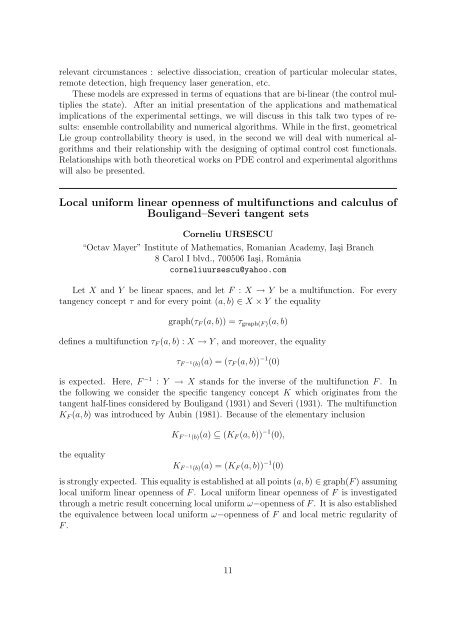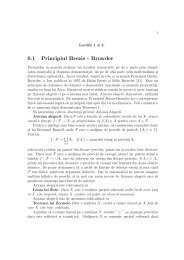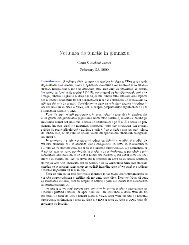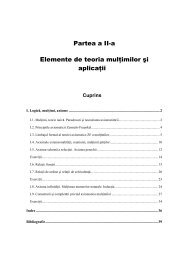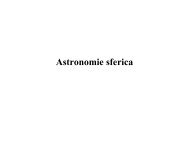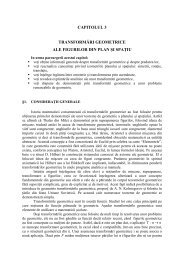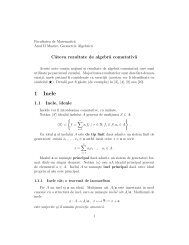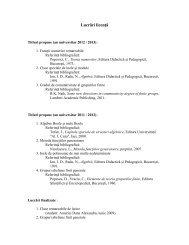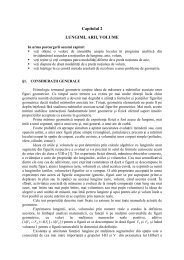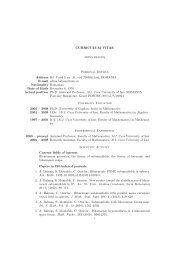Abstracts - Facultatea de Matematică
Abstracts - Facultatea de Matematică
Abstracts - Facultatea de Matematică
You also want an ePaper? Increase the reach of your titles
YUMPU automatically turns print PDFs into web optimized ePapers that Google loves.
elevant circumstances : selective dissociation, creation of particular molecular states,<br />
remote <strong>de</strong>tection, high frequency laser generation, etc.<br />
These mo<strong>de</strong>ls are expressed in terms of equations that are bi-linear (the control multiplies<br />
the state). After an initial presentation of the applications and mathematical<br />
implications of the experimental settings, we will discuss in this talk two types of results:<br />
ensemble controllability and numerical algorithms. While in the first, geometrical<br />
Lie group controllability theory is used, in the second we will <strong>de</strong>al with numerical algorithms<br />
and their relationship with the <strong>de</strong>signing of optimal control cost functionals.<br />
Relationships with both theoretical works on PDE control and experimental algorithms<br />
will also be presented.<br />
Local uniform linear openness of multifunctions and calculus of<br />
Bouligand–Severi tangent sets<br />
Corneliu URSESCU<br />
“Octav Mayer” Institute of Mathematics, Romanian Aca<strong>de</strong>my, Ia¸si Branch<br />
8 Carol I blvd., 700506 Ia¸si, România<br />
corneliuursescu@yahoo.com<br />
Let X and Y be linear spaces, and let F : X → Y be a multifunction. For every<br />
tangency concept τ and for every point (a, b) ∈ X × Y the equality<br />
graph(τF (a, b)) = τgraph(F )(a, b)<br />
<strong>de</strong>fines a multifunction τF (a, b) : X → Y , and moreover, the equality<br />
τ F −1 (b)(a) = (τF (a, b)) −1 (0)<br />
is expected. Here, F −1 : Y → X stands for the inverse of the multifunction F . In<br />
the following we consi<strong>de</strong>r the specific tangency concept K which originates from the<br />
tangent half-lines consi<strong>de</strong>red by Bouligand (1931) and Severi (1931). The multifunction<br />
KF (a, b) was introduced by Aubin (1981). Because of the elementary inclusion<br />
the equality<br />
K F −1 (b)(a) ⊆ (KF (a, b)) −1 (0),<br />
K F −1 (b)(a) = (KF (a, b)) −1 (0)<br />
is strongly expected. This equality is established at all points (a, b) ∈ graph(F ) assuming<br />
local uniform linear openness of F . Local uniform linear openness of F is investigated<br />
through a metric result concerning local uniform ω−openness of F . It is also established<br />
the equivalence between local uniform ω−openness of F and local metric regularity of<br />
F .<br />
11


